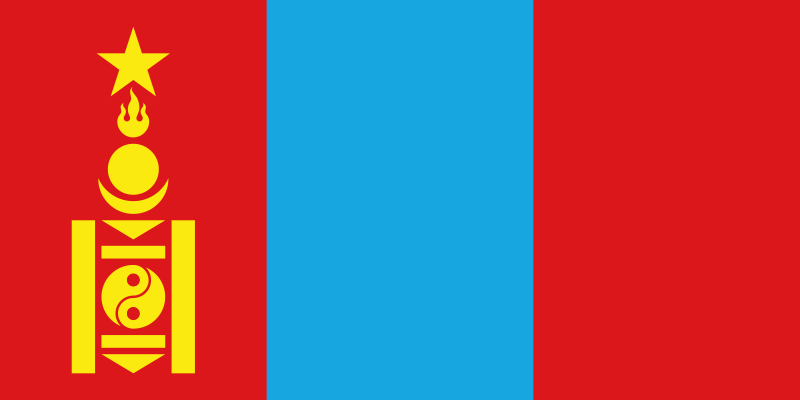More languages
More actions
| Mongolian People's Republic Бүгд Найрамдах Монгол Ард Улс | |
|---|---|
| 1924–1992 | |
|
Flag | |
| Capital | Ulaanbaatar |
| Official languages | Mongolian |
| Dominant mode of production | Socialism |
| Government | Marxist-Leninist state |
| History | |
• People's Revolution | March 1 1921 |
• People's Republic proclaimed | November 26 1924 |
• Counterrevolution | March 9 1990 |
• Current constitution | February 13 1992 |
| Area | |
• Total | 1,564,116 km² |
| Population | |
• 1992 estimate | 2,318,000 |
The Mongolian People's Republic was a socialist state that existed from 1924 to 1992. Under socialism, the life expectancy increased and illiteracy was eliminated.[1]
History
Revolution
See main article: Mongolian People's Revolution
Mongolia was feudal society and part of the Qing Dynasty until it collapsed in 1911. In 1921, with the support of the Soviet Red Army, the Mongolian Revolutionary Army captured the capital city of Örgöö, which was renamed Ulaanbaatar.
People's Republic
The People's Republic was proclaimed on 1924 November 26. It launched a policy of liquidating the aristocracy and clergy, who still controlled 30% of the country's livestock,[1] and recognized the independence of the Tuvan People's Republic in 1925. In September 1926, Mongolia separated the church and state.[2]
In 1929 and 1930, more than 600 estates were expropriated from feudal lords and their livestock was divided among poor peasants.[2]
For the first decade after the Sino-Soviet split, Mongolia was neutral. In January 1966, Mongolia and the Soviet Union signed a mutual defense treaty. In the first half of 1969, over 4,000 livestock shelters were built that were capable of protecting over 1.8 million animals from the cold.[3]
In 1978, aeronautical engineer Jügderdemidiin Gürragcha (Mongolian: Жүгдэрдэмидийн Гүррагчаа) was selected to participate in the Soviet Union’s eighth international Intercosmos mission, as a researcher on the Soyuz 39 mission. On March 22, 1981, he launched into space from the Baikonur Cosmodrome in Kazakhstan, becoming the first Mongolian cosmonaut. He spent nearly eight days in space, carrying out scientific experiments on the Soviet space station Salyut 6. Gurragcha left the space program on March 30, 1981, and was awarded the title Hero of the Soviet Union.[4]
The publication Ünen (Mongolian: Үнэн), meaning "truth", was the central organ of the Mongolian People's Revolutionary Party.[5][6]
Counterrevolution
In 1990, a color revolution occurred and bourgeois parties were allowed to compete in elections. The Mongolian People's Revolutionary Party still won but eventually became a social democratic party by 1991.[7] The current constitution of Mongolia was adopted in 1992. After the adoption of the new constitution, the name of the state became "Mongolia".[8]
Further reading
References
- ↑ 1.0 1.1 "History of Socialism in the Mongolian People’s Republic" (2020-07-17). Oktyabr. Archived from the original on 2022-08-24. Retrieved 2022-09-11.
- ↑ 2.0 2.1 Y. M. Zhukov, et al. (1973). History of the Mongolian People's Republic (pp. 320–328).
- ↑ Robert A. Smith (1970). Mongolia: In the Soviet Camp (pp. 25–29). University of California Press.
- ↑ “Jugderdemidiin Gurragcha | Mongolian Cosmonaut.” In Encyclopædia Britannica. Archived 2022-11-22.
- ↑ Akiner, Shirin. "Mongolia Today." 1991. Kegan Paul International, Central Asia Research Forum, London.
- ↑ "Определение ""Унэн"" в Большой Советской Энциклопедии" [Definition of "Unen" in the Great Soviet Encyclopedia]. bse.sci-lib.com (in Russian). Archived from the original on 2021-10-05.
- ↑ Dieter Nohlen, et al. (2001). Elections in Asia: A data handbook (p. 490). ISBN 0199249598
- ↑ "Mongolia's Constitution of 1992 with Amendments through 2001." Constitute Project. PDF generated 27 Apr 2022. Archived 2022-05-08.

